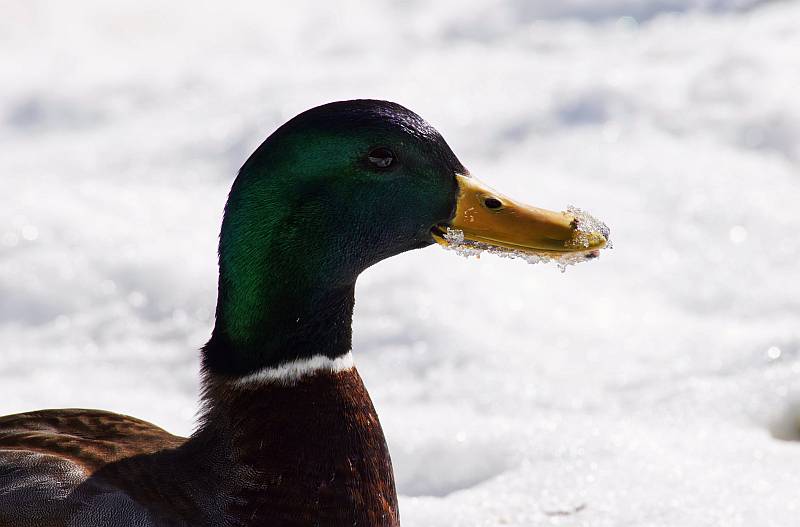Did you know that the average body temperature of a duck is around 107 degrees Fahrenheit, significantly higher than the human body temperature? That’s right, your quacking friends run hotter than you do.
Now, you might find yourself wondering, with such a high body temperature, how do ducks fare in cold weather? Do ducks get cold like we humans do or does their unique physiology offer them some form of resistance?
Well, you’re about to discover some fascinating aspects of duck biology and behavior that might just surprise you. Let’s explore this together, shall we?
Understanding Duck’s Body Temperature
While you might think ducks would struggle with cold temperatures, their bodies are actually designed to withstand a wide range of weather conditions. Unlike humans, ducks have a unique physiological makeup that allows them to adjust to temperature variations.
The most remarkable aspect is their resistance to ‘Duck Hypothermia’. Ducks possess a counter-current heat exchange system in their legs, which helps maintain body temperature. When blood flows from their body to their legs, it’s warm. But as it returns, it cools down due to the outside temperature. This cold blood is warmed up again when it comes near the warm blood going down to the legs, thus preventing hypothermia.
Their feathers also play a critical role. They’re coated with a waterproof substance that keeps them dry and warm, even in freezing temperatures. Beneath these feathers, a layer of down provides additional insulation.
Duck Feathers: Nature’s Insulation
Consider the structure of duck feathers – a marvel of nature that’s perfectly designed for insulation.
You’ll find it fascinating how ducks maintain these feathers through elaborate preening rituals.
As winter approaches, this intricate feather insulation system keeps ducks warm, even on the coldest days.
Structure of Duck Feathers
You mightn’t realize it, but duck feathers are a marvel of nature’s insulation, ingeniously structured to keep the bird warm even in the coldest conditions. Each feather has a main shaft, or rachis, from which numerous barbs branch out. These barbs, in turn, bear thousands of smaller barbules that overlap to create a tight, interlocking surface. This structure traps air, creating an insulating layer that keeps the cold out and the warmth in.
Feather evolution has engineered them to be lightweight yet sturdy, further enhancing their insulating properties. Feather pigmentation, meanwhile, offers not just beauty but also protective camouflage.
Their intricate structure and properties prove that duck feathers are nature’s masterclass in bio-engineering and insulation.
Feather Maintenance Habits
In light of these unique properties, it’s fascinating to examine how ducks meticulously maintain their feather insulation, a key survival habit that allows them to weather even the harshest climates. Their feather cleaning process, known as preening, is integral to this. Ducks use their bills to distribute oils, originating from a gland near their tail, across their feathers. This oil waterproofs the feathers, preserving their insulation quality.
Moreover, ducks follow specific molting patterns, shedding old, damaged feathers and replacing them with new ones. This usually occurs twice a year, ensuring the effectiveness of their insulation.
Insulation During Winter
As winter descends and temperatures plummet, ducks don’t just survive, they thrive, thanks largely to their remarkable feather insulation. Their feathers, especially the downy underlayer, trap air and body heat, serving as a protective shelter against the cold.
Consider the information in this table:
| Survival Strategy | Impact |
|---|---|
| Duck Migration | Allows ducks to find warmer climates, food sources, and suitable breeding grounds. |
| Feather Insulation | Traps body heat and serves as a natural, efficient insulator against the cold. |
| Protective Shelters | Offer safety from predators and harsh weather, contributing to duck survival in winter. |
Understand that ducks are well-equipped to handle harsh winter conditions. Their survival strategies, including efficient feather insulation, duck migration, and use of protective shelters, are all integral to their winter survival.
How Ducks Stay Warm in Water
Despite the frigid temperatures, ducks manage to stay warm in water through a remarkable combination of physiological and behavioral adaptations. They’ve developed efficient swimming techniques and mechanisms to prevent duck hypothermia.
Here are some of the adaptations ducks have evolved:
- Countercurrent Heat Exchange System
- Ducks have a complex network of veins and arteries in their legs, which work in a countercurrent fashion. This system prevents loss of body heat by exchanging warm arterial blood with cold venous blood, therefore keeping their core body temperature stable.
- Insulating Layer of Fat and Feathers
- Ducks have a layer of fat underneath their skin and a thick layer of feathers. These provide insulation from cold water, preventing body heat loss.
- They also produce an oil that makes their feathers waterproof, further enhancing the insulation.
- Behavioral Adaptations
- Ducks frequently fluff their feathers, creating air pockets that serve as additional insulation.
- They also reduce their activity levels in extremely cold conditions to conserve energy and limit exposure to cold.
With these adaptations, ducks not only survive but thrive in icy waters. You’d be amazed at how resilient these creatures are, wouldn’t you?
Food Consumption and Metabolism
Feasting on a diet rich in nutrients, ducks fuel their high metabolism, which plays a critical role in keeping their body temperature stable during cold conditions. Just like you’d layer up during winter, ducks undergo dietary changes to adapt to the chilly environment. They consume more fatty and protein-rich foods to increase their metabolic rate, creating more heat and energy. This metabolic shift ensures they can survive even the harshest winters.
To help you understand this, let’s break it down in a table:
| Stage | Diet | Metabolic Shift |
|---|---|---|
| Pre-Winter | Balanced | Normal |
| Winter | High Fat/Protein | Increased |
| Post-Winter | Balanced | Normal |
Ducks’ Behavioral Adaptations to Cold
In addition to their metabolic adaptations, ducks also display unique behaviors to cope with freezing temperatures. These survival tactics are crucial for their well-being in harsh winter conditions.
- Duck Migration:
- Ducks are known for their annual migration, a strategy to flee from freezing temperatures. They travel thousands of miles to warmer regions for their survival during winters.
- This behavioral adaptation stems from their instinctive drive to find resources and breed in favorable conditions.
- It’s an energy-consuming process, but it ensures their survival.
- Feathering and Huddling:
- Ducks fluff up their feathers, creating air pockets for insulation, conserving body heat.
- They also tuck their bills into their back feathers while resting, reducing heat loss.
- Huddling is another behavioral adaptation; by staying close to each other, they share warmth.
- Fasting and Resting:
- During extremely cold weather, ducks may reduce their activity and food intake, conserving energy.
- They’ll spend more time resting and less time foraging.
- This fasting period can be a survival tactic during severe winter conditions.
Understanding these behaviors can help you appreciate the complexity of their survival mechanisms in the cold.
Debunking Myths: Ducks and Cold Weather
You may think ducks get frosty due to their watery habitats, but let’s debunk some common myths about ducks and cold weather. Remember, these creatures have unique adaptations to withstand frigid temperatures.
Duck’s Cold Weather Adaptations
Despite common assumptions, ducks have evolved numerous adaptations to help them withstand cold weather conditions. Their aquatic adaptations and migration patterns play significant roles in their survival strategies. Here’s how:
- Aquatic Adaptations
- Ducks have a thick layer of fat that acts as insulation, keeping them warm in freezing temperatures.
- Their feet have a counter-current heat exchange system that minimizes heat loss.
- Duck Migration Patterns
- Ducks migrate to warmer regions during the cold seasons, a strategy that helps them escape harsh winter conditions.
- They follow specific routes, known as flyways, which provide food and safety during their journey.
Misconceptions About Duck Thermoregulation
Let’s dive into some of the most common misconceptions about how ducks handle cold weather, clearing up misunderstandings with scientific facts.
One major fallacy is that ducks migrate solely to escape the cold. In reality, duck migration is more about food availability than temperature.
Another myth is that ducks are susceptible to frostbite. However, thanks to thermoregulation evolution, ducks have counter-current heat exchange systems in their feet, preventing freeze injuries.
Many also believe that ducks need warm shelter in winter. Contrarily, their down feathers provide excellent insulation, keeping them warm in subzero temperatures.
Frequently Asked Questions
Can Ducks Survive in Extremely Low Temperatures Like in the Arctic Regions?
Yes, you’ll find certain Arctic duck species can withstand extremely low temperatures due to their unique adaptive features. Their migration patterns also help them avoid harsh winters, ensuring their survival in such conditions.
What Health Issues Can Ducks Face if They Are Exposed to Prolonged Cold Weather?
If ducks are exposed to harsh, chilly conditions for too long, they can develop health issues. Duck hypothermia becomes a risk, despite their feather insulation. So, you’ve got to ensure they’re not enduring prolonged cold.
Are There Certain Types of Ducks That Are More Resistant to Cold Than Others?
Yes, there’s variation in duck breeds’ resilience to the cold. For instance, Mallards and Pekins have strong cold adaptation mechanisms, allowing them to tolerate lower temperatures better than other duck breeds.
How Do Ducks Keep Their Eggs Warm During Cold Weather?
Ducks utilize nest insulation techniques, using feathers and nearby materials, to keep their eggs warm during cold weather. You’ll also find them actively sitting on their eggs during incubation periods to maintain the needed warmth.
Can a Duck’s Ability to Withstand Cold Weather Be Affected by Its Age or Health Condition?
Yes, a duck’s age and health can impact its ability to withstand cold. Older or ill ducks might not produce enough feather insulation, increasing their risk for duck hypothermia. They’re more vulnerable in cold conditions.
Conclusion
So, you see, ducks aren’t as chilly as you might think! Imagine them as feathered thermos flasks, their bodies swaddled in nature’s finest insulation, bobbing serenely in icy waters.
Their hearty appetite fuels their internal furnace, staving off the cold. With smart behaviors and biological tricks up their sleeves, they debunk the myth of being cold-blooded.
After all, they’re not just surviving in the cold, they’re thriving!

